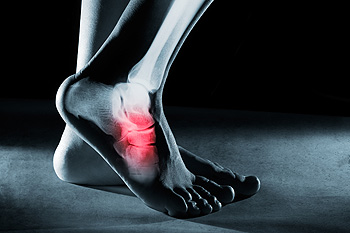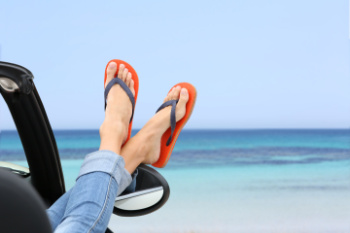Connect With Us
Blog
Items filtered by date: July 2024
Causes and Sensations of Foot Stress Fractures

A foot stress fracture manifests as a small crack or severe bruising within a bone, typically caused by repetitive force or overuse, such as high-impact activities like running or jumping. This injury often results from sudden increases in activity intensity or duration, wearing inadequate footwear support, or changes in training surfaces. Symptoms can include localized pain and tenderness, swelling, and difficulty bearing weight on the affected foot. The pain associated with a stress fracture is often described as dull and achy initially, worsening with activity and subsiding with rest. In some cases, there may be a noticeable tenderness or throbbing sensation at the fracture site. Prompt diagnosis through imaging techniques like X-rays or MRI scans is essential to differentiate a stress fracture from other foot injuries and initiate appropriate treatment. If you have foot pain, and believe it may be a stress fracture, it is suggested that you visit a podiatrist who can determine what the most appropriate course of treatment is for you.
Activities where too much pressure is put on the feet can cause stress fractures. To learn more, contact one of our podiatrists from Save Your Soles. our doctors can provide the care you need to keep your pain free and on your feet.
Dealing with Stress Fractures of the Foot and Ankle
Stress fractures occur in the foot and ankle when muscles in these areas weaken from too much or too little use. The feet and ankles then lose support when walking or running from the impact of the ground. Since there is no protection, the bones receive the full impact of each step. Stress on the feet can cause cracks to form in the bones, thus creating stress fractures.
What Are Stress Fractures?
Stress fractures occur frequently in individuals whose daily activities cause great impact on the feet and ankles. Stress factors are most common among:
- Runners
- People affected with Osteoporosis
- Tennis or basketball players
- Gymnasts
- High impact workouts
Symptoms
Pain from the fractures occur in the area of the fractures and can be constant or intermittent. It will often cause sharp or dull pain with swelling and tenderness. Engaging in any kind of activity which involves high impact will aggravate pain.
If you have any questions please feel free to contact our offices located in Abington and Willow Grove, PA . We offer the newest diagnostic and treatment technologies for all your foot and ankle needs.
Facts About Ankle Injuries in Soccer

Ankle injuries are prevalent in soccer, with acute ankle sprains being the most common. These occur when the ligaments surrounding the ankle are stretched or torn, usually from sudden twists, turns, or impacts. Symptoms include pain, swelling, and difficulty bearing weight on the affected foot. Immediate relief tactics involve rest, compression, and elevation. Resting prevents further injury, and elevation can help to reduce swelling, in addition to compression with an elastic bandage. Rehabilitation exercises, such as gentle range-of-motion and strengthening activities can aid in recovery and prevent future injuries. Wearing proper footwear and using ankle supports during play can also help reduce the risk. If you have suffered an ankle injury while playing soccer, it is suggested that you visit a podiatrist who can offer effective treatment solutions, and guide you on additional injury prevention strategies.
Sports related foot and ankle injuries require proper treatment before players can go back to their regular routines. For more information, contact one of our podiatrists of Save Your Soles. our doctors can provide the care you need to keep you pain-free and on your feet.
Sports Related Foot and Ankle Injuries
Foot and ankle injuries are a common occurrence when it comes to athletes of any sport. While many athletes dismiss the initial aches and pains, the truth is that ignoring potential foot and ankle injuries can lead to serious problems. As athletes continue to place pressure and strain the area further, a mild injury can turn into something as serious as a rupture and may lead to a permanent disability. There are many factors that contribute to sports related foot and ankle injuries, which include failure to warm up properly, not providing support or wearing bad footwear. Common injuries and conditions athletes face, including:
- Plantar Fasciitis
- Plantar Fasciosis
- Achilles Tendinitis
- Achilles Tendon Rupture
- Ankle Sprains
Sports related injuries are commonly treated using the RICE method. This includes rest, applying ice to the injured area, compression and elevating the ankle. More serious sprains and injuries may require surgery, which could include arthroscopic and reconstructive surgery. Rehabilitation and therapy may also be required in order to get any recovering athlete to become fully functional again. Any unusual aches and pains an athlete sustains must be evaluated by a licensed, reputable medical professional.
If you have any questions please feel free to contact our offices located in Abington and Willow Grove, PA . We offer the newest diagnostic and treatment technologies for all your foot and ankle needs.
Treatment of Adult Acquired Flat Feet

Adult-acquired flatfoot, also known as posterior tibial tendon dysfunction, can be a source of significant discomfort for many adults. Adult-acquired flatfoot develops when the posterior tibial tendon weakens, causing the arch of the foot to collapse gradually. Symptoms can include pain along the inside of the ankle, swelling, difficulty standing on tiptoes, and increased discomfort during weight-bearing activities. A podiatrist can perform an assessment of your foot's flexibility and alignment, and may order X-rays or other imaging techniques to assess the condition of the tendon and bones. Treatment options typically start conservatively with custom orthotics or ankle braces to support the foot and alleviate pain. Activity modifications and anti-inflammatory medications may also be recommended. In cases where conservative treatments do not provide sufficient relief, surgical tendon repair or fusion procedures may be considered to restore stability and function to the affected foot. If you are experiencing problems related to flat feet, it is suggested that you schedule an appointment with a podiatrist for treatment.
Flatfoot is a condition many people suffer from. If you have flat feet, contact one of our podiatrists from Save Your Soles. our doctors will treat your foot and ankle needs.
What Are Flat Feet?
Flatfoot is a condition in which the arch of the foot is depressed and the sole of the foot is almost completely in contact with the ground. About 20-30% of the population generally has flat feet because their arches never formed during growth.
Conditions & Problems:
Having flat feet makes it difficult to run or walk because of the stress placed on the ankles.
Alignment – The general alignment of your legs can be disrupted, because the ankles move inward which can cause major discomfort.
Knees – If you have complications with your knees, flat feet can be a contributor to arthritis in that area.
Symptoms
- Pain around the heel or arch area
- Trouble standing on the tip toe
- Swelling around the inside of the ankle
- Flat look to one or both feet
- Having your shoes feel uneven when worn
Treatment
If you are experiencing pain and stress on the foot you may weaken the posterior tibial tendon, which runs around the inside of the ankle.
If you have any questions please feel free to contact our offices located in Abington and Willow Grove, PA . We offer the newest diagnostic and treatment technologies for all your foot and ankle needs.
The Hidden Dangers of Flip-Flops on Your Feet
 Flip-flops, though convenient, can be harsh on your feet, especially for individuals at risk like those with diabetes. The lack of support in flip-flops leads to improper heel strike, causing stress on the heels and increasing the risk of plantar fasciitis. Further, to keep the flip flops on, wearers often grip with their toes, which can cause muscle strain and negatively affect conditions like hammertoes. For people with diabetes, the minimal protection provided by flip-flops increases the risk of cuts, blisters, and infections due to decreased sensation and poor wound healing. Additionally, the flat design offers little or no arch support, leading to pain and discomfort in the feet and ankles. If you have foot pain as a result of wearing flip-flops, it is suggested that you consult a podiatrist who can offer you relief tips, in addition to guiding you on more favorable footwear choices.
Flip-flops, though convenient, can be harsh on your feet, especially for individuals at risk like those with diabetes. The lack of support in flip-flops leads to improper heel strike, causing stress on the heels and increasing the risk of plantar fasciitis. Further, to keep the flip flops on, wearers often grip with their toes, which can cause muscle strain and negatively affect conditions like hammertoes. For people with diabetes, the minimal protection provided by flip-flops increases the risk of cuts, blisters, and infections due to decreased sensation and poor wound healing. Additionally, the flat design offers little or no arch support, leading to pain and discomfort in the feet and ankles. If you have foot pain as a result of wearing flip-flops, it is suggested that you consult a podiatrist who can offer you relief tips, in addition to guiding you on more favorable footwear choices.
Flip-flops are not always the best choice of footwear. If you have any concerns about your feet or ankles, contact one of our podiatrists from Save Your Soles. our doctors will assist you with all of your foot and ankle needs.
Flip-Flops and Feet
When the weather starts warming up, people enjoy wearing flip-flops. Flip-flops are comfortable, stylish, and easy to slip on and off; they're perfect for any summer beach goer. However, these shoes can cause harm to the feet.
How Can Flip-Flops Affect Me Long-Term?
- Ankle problems
- Hip problems
- Lower back problems
- Pain in the balls of the feet
- Problems with foot arches
- Changes in the way you walk
Are There Injuries Associated with Flip-Flops?
Yes. Since flip-flops are relatively weak and do not provide the same amount of support as sneakers, people who wear flip-flops regularly are more susceptible to injuries. On top of that, the open nature of the shoe makes your feet more prone to other problems, such as cuts and even infections. Common injuries and ailments include:
- Sprained ankles
- Blisters
- Infections
- Cuts and Scrapes
I like Wearing Flip-Flops. Are There Safe Alternatives?
When buying flip-flops, try to find ones that have sturdy soles and that are made of high-quality materials that will support for your feet. These flip-flops will cost more but will also last longer as a result.
If you have any questions please feel free to contact our offices located in Abington and Willow Grove, PA . We offer the newest diagnostic and treatment technologies for all your foot and ankle needs.
Tarsal Tunnel Syndrome Causes Heel Pain
 Heel pain is a common complaint that can significantly impact daily activities. Heel pain often stems from tarsal tunnel syndrome, where the tibial nerve gets squeezed within the tight passage along the inner ankle, known as the tarsal tunnel. This compression can occur due to injury, swelling, or structural issues like flat feet. Symptoms of tarsal tunnel syndrome include numbness or tingling in the heel, arch, or sole of the foot. This condition can be irritated by activities that put immense pressure on the foot, such as standing or walking for prolonged periods. Treatment options for tarsal tunnel syndrome include rest, ice therapy, and in severe cases, surgery to relieve pressure on the affected nerve. If this condition is left untreated, tarsal tunnel syndrome can worsen, leading to chronic pain and potentially affecting mobility. If you notice any signs of tarsal tunnel syndrome or heel pain, it is suggested to schedule an appointment with a podiatrist for a proper diagnosis and treatment options.
Heel pain is a common complaint that can significantly impact daily activities. Heel pain often stems from tarsal tunnel syndrome, where the tibial nerve gets squeezed within the tight passage along the inner ankle, known as the tarsal tunnel. This compression can occur due to injury, swelling, or structural issues like flat feet. Symptoms of tarsal tunnel syndrome include numbness or tingling in the heel, arch, or sole of the foot. This condition can be irritated by activities that put immense pressure on the foot, such as standing or walking for prolonged periods. Treatment options for tarsal tunnel syndrome include rest, ice therapy, and in severe cases, surgery to relieve pressure on the affected nerve. If this condition is left untreated, tarsal tunnel syndrome can worsen, leading to chronic pain and potentially affecting mobility. If you notice any signs of tarsal tunnel syndrome or heel pain, it is suggested to schedule an appointment with a podiatrist for a proper diagnosis and treatment options.
Many people suffer from bouts of heel pain. For more information, contact one of our podiatrists of Save Your Soles. our doctors can provide the care you need to keep you pain-free and on your feet.
Causes of Heel Pain
Heel pain is often associated with plantar fasciitis. The plantar fascia is a band of tissues that extends along the bottom of the foot. A rip or tear in this ligament can cause inflammation of the tissue.
Achilles tendonitis is another cause of heel pain. Inflammation of the Achilles tendon will cause pain from fractures and muscle tearing. Lack of flexibility is also another symptom.
Heel spurs are another cause of pain. When the tissues of the plantar fascia undergo a great deal of stress, it can lead to ligament separation from the heel bone, causing heel spurs.
Why Might Heel Pain Occur?
- Wearing ill-fitting shoes
- Wearing non-supportive shoes
- Weight change
- Excessive running
Treatments
Heel pain should be treated as soon as possible for immediate results. Keeping your feet in a stress-free environment will help. If you suffer from Achilles tendonitis or plantar fasciitis, applying ice will reduce the swelling. Stretching before an exercise like running will help the muscles. Using all these tips will help make heel pain a condition of the past.
If you have any questions please contact our offices located in Abington and Willow Grove, PA . We offer the newest diagnostic and treatment technologies for all your foot and ankle needs.
